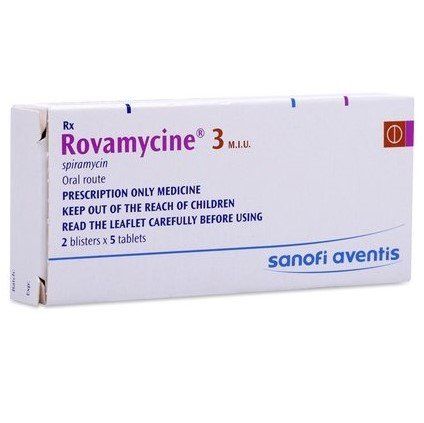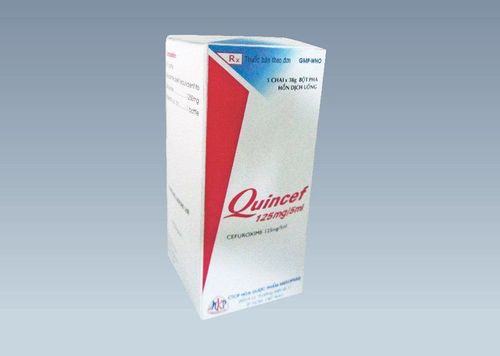This is an automatically translated article.
Medoclav is indicated for the treatment of infections of the upper and lower respiratory tract, genital tract, and skin caused by beta-lactamase-producing strains of bacteria that have not responded to treatment with aminopenicillin alone. ... In order to ensure effective treatment and avoid side effects, patients need to take drugs according to prescription or consult a doctor, pharmacist for advice.
1. What is Medoclav?
Medoclav has two main active ingredients: Amoxicillin and Clavulanic Acid. Amoxicillin is a β-lactam antibiotic with a broad bactericidal spectrum including: gram-positive and gram-negative bacteria due to inhibition of bacterial cell wall synthesis. However, Amoxicillin is easily destroyed by β-lactamase, so it has no effect on bacteria that produce this enzyme.
Clavulanic acid prevents Amoxicillin from being destroyed by β-lactamases, and extends the antibacterial spectrum of Amoxicillin to many bacteria normally resistant to amoxicillin, other penicillins and cephalosporins.
Bactericidal spectrum of the drug includes:
Gram-positive bacteria: Streptococcus faecalis, S.pneumonia, S.pyogenes, S.viridians, Staphylococcus aureus, Bacillus anthracis, Corynebacterium, Listeria monocytogenes. Species of Clostridium, Peptococcus, Peptostreptococcus. Gram-negative bacteria: Haemophilus influenza, E.coli, P.mirabilis, P.vulgaris, Klebsiella species, Shigella, Samonella, Bordetella, N.gonorrhoeae, N.meningitides, Vibrio Cholerae, Pasteurella multocida, Bacteroides species. Contents of the drug forms Medoclav:
Medoclav tablets 375mg: Amoxicillin 250 mg and clavulanic acid 125 mg. Medoclav 625mg tablet: Amoxicillin 500mg and clavulanic acid 125mg. Medoclav 1g tablet: Amoxicillin 875 mg and clavulanic acid 125 mg. Each 5mL of oral suspension 156.25mg: Amoxicillin 125 mg and clavulanic acid 31.25 mg. Each 5mL oral suspension 312.5mg: Amoxicillin 250mg and clavulanic acid 62.50mg.
2. Indications of the drug Medoclav
Medoclav is indicated for the treatment of infections caused by beta-lactamase producing bacteria that have not responded to treatment with aminopenicillin alone. The drug is used for a short period of less than 14 days. Accordingly, the drug is indicated in the following cases:Severe upper respiratory tract infections: otitis media, tonsillitis, sinusitis that have been treated with conventional antibiotics but have not improved. Lower respiratory tract infections caused by strains of H. influenzae, Moraxella catarrhalis producing beta-lactamase: pneumonia, acute and chronic bronchitis,. Severe infections of the urogenital tract by susceptible beta-lactamase-producing strains of E. coli, Enterobacter and Klebsiella: pyelonephritis, cystitis, urethritis, female genital tract infections. Skin and soft tissue infections: boils, cellulitis, abscesses, wound infections, insect bites. Bone and joint infections: osteomyelitis. Infection in dentistry: alveolar abscess. Some other types of infections: intra-abdominal infections, infections caused by miscarriage, bacteremia.
3. Contraindications of the drug Medoclav
Hypersensitivity or allergy to beta-lactam antibiotics (penicillins, cephalosporins). Attention should be paid to the possibility of cross-allergy with beta-lactam antibiotics such as cephalosporin antibiotics.
Patients with a history of jaundice or hepatobiliary disorders due to the use of Amoxicillin, clavulanate acid or penicillins.
4. How to take Medoclav
Medoclav is a prescription drug, so you should take it as directed by your doctor. Medoclav should not be used for more than 14 days and should be taken at the beginning of a meal, this will help reduce the phenomenon of drug intolerance in the gastrointestinal tract.
Powder for oral suspension: Shake gently to loosen the powder in the bottle, add water to the mark and shake well before use.
The following factors should be considered before taking the drug:
The susceptibility of bacteria to antibiotics. Degree and location of infection. Weight, age, and renal function of the patient. The duration of dosing should depend on the patient's response. Some infections (such as osteomyelitis) require longer treatment. A course of Medoclav should not exceed 14 days without re-examination.
Adults and children ≥ 40kg: 500mg Amoxicillin/125mg Clavulanic Acid x 3 times/day. The total dose is 1500 mg amoxicillin/375 mg clavulanic acid. Children < 40 kg: 20 -60 mg Amoxicillin/5 mg clavulanic acid/kg/day x 3 times/day. If higher doses of Amoxicillin are required, use another preparation to avoid unnecessary doses of clavulanic acid. Medoclav should not be used in infants and children under 3 months of age. Renal impairment: The dose is adjusted according to the maximum recommended dose of amoxicillin. No dose adjustment is required for patients with creatinine clearance greater than 30 ml/min. Hepatic impairment: Renal during use and periodic liver function tests.
5. What to do in case of an overdose of Medoclav?
5.1.Symptoms of overdose Digestive disorders include: abdominal pain, vomiting, diarrhea are common symptoms when taking an overdose of Medoclav. Less common symptoms include: increased agitation, drowsiness, rash, interstitial nephritis or crystaluria leading to renal failure, reversible kidney damage.
5.2. Treatment of drug overdose Discontinue use, treat symptomatically and provide support if necessary. If occurs early and there are no contraindications induce vomiting or gastric lavage. Overdosage of less than 250 mg/kg and causing no particular symptoms does not require gastric emptying. Crystalline : Provide enough water and electrolytes to maintain diuresis and reduce the risk of crystalluria. The kidney damage in this case is usually reversible upon discontinuation of the drug. Hypertension may be seen in patients with impaired renal function due to decreased excretion of amoxicillin and clavulanic acid. The drug is removed from the circulation by hemodialysis.
6. Side effects of the drug Medoclav
When using a mixture of Amoxicillin and Potassium clavulanate, undesirable effects are usually mild and transient, only less than 3% of patients have to stop taking the drug.
Digestion: common diarrhea (9%). Nausea and vomiting (1-5%) are commonly associated with clavulanic acid (250mg dose increases risk more than 40% compared with 125mg). Skin: itching, rash (3%). Uncommon: headache, fatigue, hepatitis, cholestatic jaundice, elevated liver enzymes, eosinophilia, Candida vaginitis. Rare: anaphylactic reactions, Quincke's edema. Blood: hemolytic anemia, mild thrombocytopenia, leukopenia. Skin: erythema multiforme, exfoliative dermatitis, Stevens-Johnson syndrome, toxic epidermal necrolysis. Interstitial nephritis: Pseudomembranous colitis. Discontinue Medoclav immediately and seek emergency treatment for allergic reactions such as erythema, anaphylaxis, Quincke's edema, Stevens-Johnson syndrome. Patients should no longer be treated with penicillins or cephalosporins.
Pseudomembranous colitis: mild form requiring discontinuation of the drug; Severe cases (possibly due to Clostridium difficile) require fluid and electrolyte replacement, anti-clostridium antibiotics such as Metronidazol and Vancomycin.
7. Precautions while using Medoclav
Patients with a history of allergy to penicillins, cephalosporins or other allergens may experience severe hypersensitivity reactions. Careful history should be taken in these patients. Clavulanate acid increases the risk of intrahepatic cholestasis, so it should be used with caution in the elderly, people with a history of jaundice/hepatic dysfunction when taking amoxicillin and clavulanate potassium. Cholestatic jaundice rarely occurs with the drug but can be severe. Usually symptoms will recover and disappear after about 6 weeks of stopping the drug. Renal impairment: Dosage should be adjusted according to creatinine clearance. It is necessary to pay attention to liver and kidney function, hematological index during treatment. Diarrhea requires the differential diagnosis of Clostridium difficile and pseudomembranous colitis. Pregnant women: there is not enough experience in using this drug for this population. Therefore, it is necessary to avoid using the drug for pregnant women, especially the first 3 months. In case of necessity, use must be prescribed by a doctor. Nursing Mothers: The drug can still be used, in fact very small amounts are excreted in breast milk, but it is not usually harmful, unless there is a risk of sensitization in the baby.
8. Medoclav drug interactions
Medoclav medicine can interact with some drugs and increase side effects:
Allopurinol : increases the risk of Amoxicillin rash. Anticoagulants: Due to their ability to prolong bleeding and clotting time. Contraceptives: Concomitant use of Medoclav reduces the effectiveness of oral contraceptives. Other antibiotics such as Macrolid, Chloramphenicol, Sulfonamide and Tetracycline. Nifedipine: Increases the absorption of Amoxicillin. Bacteriostatic agents such as Chloramphennicol, Fusidic Acid, Tetracycline. Methotrexate: increases drug excretion, increases toxicity on the digestive system and hematopoiesis. Medoclav is indicated for the treatment of upper and lower respiratory tract infections. To ensure the effectiveness of treatment and avoid side effects, patients need to take medicine according to prescription or consult a doctor, pharmacist for advice.
Follow Vinmec International General Hospital website to get more health, nutrition and beauty information to protect the health of yourself and your loved ones in your family.
Please dial HOTLINE for more information or register for an appointment HERE. Download MyVinmec app to make appointments faster and to manage your bookings easily.













